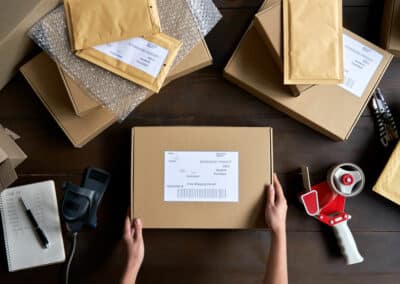3. Spoil your regular customers and win over new ones
Efforts to attract shoppers on Black Friday typically focus solely on acquiring new customers. But loyal existing customers also shop during Black Week & Co.
You should pay special attention to the latter – for example, by telling them about upcoming discounts in advance through newsletters and in the store itself. This will make them want to buy even more. It may even be worthwhile to have a special pre-sale or some offers exclusively for existing customers.
For new customers, the most important thing is to make them feel welcome. After all, there are many users on the site who are unfamiliar with your products and brand. So make sure you have good product descriptions and explanations of your items. This will leave fewer questions unanswered and avoid potential disappointment when unpacking. Tip: It is worth taking a look at reviews of previous purchases and information on reasons for returns. For example, if a common complaint is that a product is too small, you can add a note to that effect in the store.
4. Control logistics costs with cross-selling and up-selling
There are logistics costs associated with every order, and with high discounts, these costs can quickly eat into margins. Therefore, the basket value should be as high as possible. This is where a sophisticated cross-sell and up-sell strategy pays off. Recommendations for other suitable products or volume discounts increase the chance that more items will end up in the shopping cart. This encourages shoppers to buy more than they had planned. This also pays off in the long run. By eliminating the need to package and ship items individually, you save on fulfillment and logistics costs.
You can also bundle the products, which is less expensive than buying them individually. Of course, this requires that your logistics provider supports this option. Did you know that you can easily create and modify bundles on the Alaiko platform? Digital processes ensure that inventory levels are adjusted accordingly after bundle orders.
5. Streamline the returns process
An easy returns process is also part of optimizing the shopping experience. The first step is to manage returns. You should use a returns portal for this. If customers can initiate the return themselves, provide a reason, and download the label, they won’t have to wait long for a response from customer service. This is a win-win situation: your customer service is relieved and your customers are satisfied. You can export the return reasons listed in the returns portal and use them to further optimize your store and products.
The topic of refunds also offers potential for optimization. On the one hand, you can offer customers a gift certificate or an exchange instead of a full refund. They can also choose this directly in the returns portal and even order their replacement item there. This way, you may not lose the sale after all.
If customers still want a refund, make it as quick as possible – and keep your customer service time to a minimum. This works for Shopify stores with automated refunds. You can define which items should be refunded directly (e.g. only A-goods), and as soon as the return is processed in the warehouse, the refund is automatically triggered.





